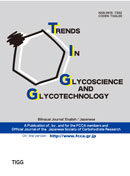
- Issue 202 Pages E107-
- Issue 201 Pages E85-
- Issue 200 Pages E69-
- Issue 199 Pages E55-
- Issue 198 Pages E19-
- Issue 197 Pages E1-
- |<
- <
- 1
- >
- >|
-
Yuko Naito-Matsui2022 Volume 34 Issue 199 Pages E43-E47
Published: May 25, 2022
Released on J-STAGE: May 25, 2022
JOURNAL RESTRICTED ACCESSSialic acids serve as targets for various molecular recognition events because of their location at the terminous of glycans and because they exhibit a variety of structures by various molecular modifications. Focusing on modification at the C-5 position, sialic acids in mammals are mainly categorized in two groups, N-acetylneuraminic acid and N-glycolylneuraminic acid (Neu5Gc). The ratio of these two forms varies among tissues and between animal species. There are two interesting features in Neu5Gc expression; Neu5Gc is absent in the brain of all vertebrates and absent in all human tissues. However, the physiological significance of these specific expression patterns of Neu5Gc is largely unknown. Several model mice with perturbed Neu5Gc expression were established and studies using these mice reveal that the lack of Neu5Gc is involved in some pathological conditions of human-specific diseases.
View full abstractDownload PDF (690K) -
Yoichi Takeda, Takashi Kikuma2022 Volume 34 Issue 199 Pages E49-E53
Published: May 25, 2022
Released on J-STAGE: May 25, 2022
JOURNAL RESTRICTED ACCESSUDP-glucose:glycoprotein glucosyltransferase (UGGT) functions as a sensor for monitoring the folding status of glycoproteins and transferring a glucose residue to the oligomannose-type glycans of misfolded glycoproteins. Recently, we showed that UGGT1 facilitates folding of denatured glycoproteins in vitro. In this review, we discuss whether UGGT–selenof complex acts as a chaperone for misfolded glycoproteins based on the recently revealed conformation and function of UGGT and the function of selenof, which is a UGGT-binding protein.
View full abstractDownload PDF (1585K) -
Takanori Matsumaru2022 Volume 34 Issue 199 Pages E55-E59
Published: May 25, 2022
Released on J-STAGE: May 25, 2022
JOURNAL RESTRICTED ACCESSC-type lectin receptors (CLRs), a class of pattern recognition receptors, are expressed on immune cell surfaces and regulate innate immunity by recognizing microbial or endogenous substances. Mincle, a CLR, recognizes various lipid conjugated ligands, such as glycolipids. In this review, recently synthetically accessed natural Mincle ligand-lipid conjugates as well as their analogues are discussed.
View full abstractDownload PDF (1215K)
-
Nozomi Ishii2022 Volume 34 Issue 199 Pages E61
Published: May 27, 2022
Released on J-STAGE: May 25, 2022
JOURNAL RESTRICTED ACCESSDownload PDF (289K) -
Haruki Odaka2022 Volume 34 Issue 199 Pages E63
Published: May 27, 2022
Released on J-STAGE: May 25, 2022
JOURNAL RESTRICTED ACCESSDownload PDF (228K)
-
Yuko Naito-Matsui2022 Volume 34 Issue 199 Pages J43-J47
Published: May 25, 2022
Released on J-STAGE: May 25, 2022
JOURNAL RESTRICTED ACCESSSialic acids serve as targets for various molecular recognition events because of their location at the terminous of glycans and because they exhibit a variety of structures by various molecular modifications. Focusing on modification at the C-5 position, sialic acids in mammals are mainly categorized in two groups, N-acetylneuraminic acid and N-glycolylneuraminic acid (Neu5Gc). The ratio of these two forms varies among tissues and between animal species. There are two interesting features in Neu5Gc expression; Neu5Gc is absent in the brain of all vertebrates and absent in all human tissues. However, the physiological significance of these specific expression patterns of Neu5Gc is largely unknown. Several model mice with perturbed Neu5Gc expression were established and studies using these mice reveal that the lack of Neu5Gc is involved in some pathological conditions of human-specific diseases.
View full abstractDownload PDF (665K) -
Yoichi Takeda, Takashi Kikuma2022 Volume 34 Issue 199 Pages J49-J53
Published: May 25, 2022
Released on J-STAGE: May 25, 2022
JOURNAL RESTRICTED ACCESSUDP-glucose:glycoprotein glucosyltransferase (UGGT) functions as a sensor for monitoring the folding status of glycoproteins and transferring a glucose residue to the oligomannose-type glycans of misfolded glycoproteins. Recently, we showed that UGGT1 facilitates folding of denatured glycoproteins in vitro. In this review, we discuss whether UGGT–selenof complex acts as a chaperone for misfolded glycoproteins based on the recently revealed conformation and function of UGGT and the function of selenof, which is a UGGT-binding protein.
View full abstractDownload PDF (1684K) -
Takanori Matsumaru2022 Volume 34 Issue 199 Pages J55-J59
Published: May 25, 2022
Released on J-STAGE: May 25, 2022
JOURNAL RESTRICTED ACCESSC-type lectin receptors (CLRs), a class of pattern recognition receptors, are expressed on immune cell surfaces and regulate innate immunity by recognizing microbial or endogenous substances. Mincle, a CLR, recognizes various lipid conjugated ligands, such as glycolipids. In this review, recently synthetically accessed natural Mincle ligand-lipid conjugates as well as their analogues are discussed.
View full abstractDownload PDF (1337K)
-
Nozomi Ishii2022 Volume 34 Issue 199 Pages J61
Published: May 27, 2022
Released on J-STAGE: May 25, 2022
JOURNAL RESTRICTED ACCESSDownload PDF (337K) -
Haruki Odaka2022 Volume 34 Issue 199 Pages J63
Published: May 27, 2022
Released on J-STAGE: May 25, 2022
JOURNAL RESTRICTED ACCESSDownload PDF (303K)
- |<
- <
- 1
- >
- >|